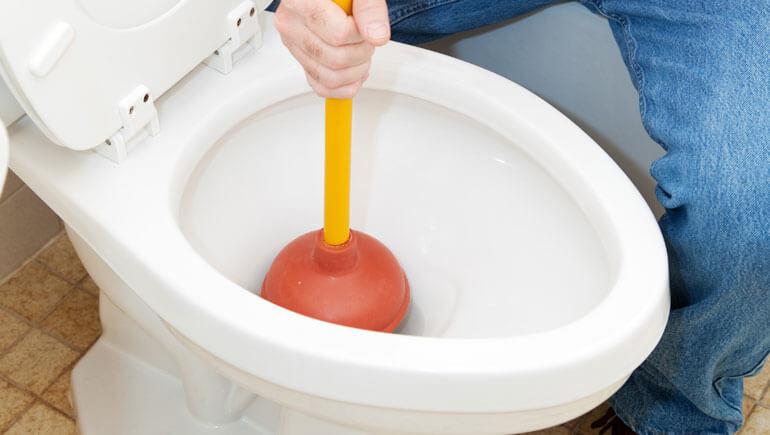Effective Plungers and Drain Cleaner: Essential Advice
Effective Plungers and Drain Cleaner: Essential Advice
Blog Article
Right here further down you will discover a lot of sound expertise pertaining to Here's How to Correctly Use a Toilet Plunger.

Intro
Correct upkeep of family drains is essential for protecting against clogs and making sure smooth water circulation. One of the secret devices in every house owner's toolkit is the bettor, along with different drain cleansers designed to tackle persistent clogs properly. This post explores just how to utilize plungers and drain cleansers properly to keep your drains pipes flowing freely.
Area 1: Understanding Plungers
Sorts of Plungers
There are a number of sorts of plungers offered, each designed for different kinds of drains pipes and blocks. One of the most typical types consist of cup bettors, flange plungers, and accordion bettors.
Exactly How Plungers Job
Plungers deal with the principle of creating stress and suction to dislodge blockages. When correctly used over a drainpipe, they develop a vacuum cleaner that can pull out particles or break up obstructions.
Choosing the Right Plunger
Choosing the right bettor depends on the type of drain and the nature of the obstruction. Mug bettors are optimal for sinks and bathtubs, while flange bettors are much better suited for bathrooms because of their style.
Usual Blunders with Bettors
Preventing these errors ensures efficient plunging: improper seal around the drain, inadequate force, and not clearing surrounding particles.
Section 2: Making Use Of Plungers Successfully
Prep work
Before diving, ensure the bettor covers the drain completely and creates a tight seal. Clear any kind of visible debris around the drainpipe opening.
Strategy
Start with mild plunging movements to build suction. Rise stress slowly, using a constant rhythm. Repeat as essential until the drainpipe removes.
Troubleshooting Tips
If diving doesn't function, try changing the seal, using oil jelly for a better seal, or making use of a various kind of bettor.
Section 3: Comprehending Drain Cleansers
Sorts Of Drainpipe Cleansers
Drain pipes cleaners can be chemical or enzymatic. Chemical cleaners utilize solid chemicals to liquify clogs, while chemical cleaners use natural enzymes to break down organic matter.
Just How Drainpipe Cleaning Company Work
Chemical cleansers respond with obstructions to dissolve them, while enzymatic cleaners break down natural products like hair and grease without harming pipelines.
Safety and security Factors to consider
Constantly wear gloves and eye defense when making use of chemical drain cleaners. Guarantee sufficient air flow and follow producer instructions carefully.
Eco-Friendly Alternatives
Take into consideration utilizing vinegar and baking soft drink or enzyme-based cleansers for green alternatives that are much safer for pipelines and the environment.
Area 4: Utilizing Drain Cleaning Company Successfully
Application Techniques
Pour chemical cleaners straight right into the drain opening. Permit them to benefit the advised time prior to purging with hot water. Enzymatic cleaners should sit over night.
Precautions
Prevent mixing various types of cleansers, as this can produce toxic fumes. Never make use of chemical cleaners combined with a plunger, as splashing can happen.
Managing Stubborn Clogs
For relentless blockages, take into consideration using a pipes snake or calling a specialist plumber to avoid damages to pipelines.
Final thought
In conclusion, understanding exactly how to use plungers and drainpipe cleaners efficiently is necessary for keeping healthy plumbing systems. By choosing the right tools and techniques, homeowners can take on small blockages and protect against major plumbing concerns down the line.
4 DIY Ways to Unclog Drains
Wire Hanger
This age-old technique has been used by many an amateur plumber – to much success. Take any wire hanger, deconstruct its shape and leave a small hook shape on the end. Time to go fishing! Remove the shower or sink drain cover and snake the wire into the drain, wiggling and rotating it as you push it through. Dispose of the gunk that you remove and flush the drain with hot water. Rinse with a pan of boiling water for best results.
Plunger
Creating a suction in your drain can break up clogs caused by hair and soap residue build up. First, make sure you are using the correct type of plunger, one specifically for sinks or tubs. They are typically smaller than regular toilet plungers and often have a shallow suction cup. Regular plungers can work too but we’d recommend cleaning them first and finding a way to create better suction over the drain.
Baking Soda and Vinegar
This technique is a classic – and one of the most popular DIY drain unclog methods. Pour one cup of baking soda and one cup of vinegar down the drain and allow it to work its magic overnight. The next morning, flush the drain with boiling water. Repeat if necessary.
Drain Snake/Hair Clog Tool
If you know your clog is caused primary by hair, a drain snake/hair clog tool might be your best option. These tools can be purchased for under $10 at any hardware store and work well so long as the clog isn’t too deep in the drain.
https://www.callcatons.com/blog/four-diy-ways-to-unclog-drains/

Application Techniques
Pour chemical cleaners straight right into the drain opening. Permit them to benefit the advised time prior to purging with hot water. Enzymatic cleaners should sit over night.
Precautions
Prevent mixing various types of cleansers, as this can produce toxic fumes. Never make use of chemical cleaners combined with a plunger, as splashing can happen.
Managing Stubborn Clogs
For relentless blockages, take into consideration using a pipes snake or calling a specialist plumber to avoid damages to pipelines.
Final thought
In conclusion, understanding exactly how to use plungers and drainpipe cleaners efficiently is necessary for keeping healthy plumbing systems. By choosing the right tools and techniques, homeowners can take on small blockages and protect against major plumbing concerns down the line.
4 DIY Ways to Unclog Drains
Wire Hanger
This age-old technique has been used by many an amateur plumber – to much success. Take any wire hanger, deconstruct its shape and leave a small hook shape on the end. Time to go fishing! Remove the shower or sink drain cover and snake the wire into the drain, wiggling and rotating it as you push it through. Dispose of the gunk that you remove and flush the drain with hot water. Rinse with a pan of boiling water for best results.
Plunger
Creating a suction in your drain can break up clogs caused by hair and soap residue build up. First, make sure you are using the correct type of plunger, one specifically for sinks or tubs. They are typically smaller than regular toilet plungers and often have a shallow suction cup. Regular plungers can work too but we’d recommend cleaning them first and finding a way to create better suction over the drain.
Baking Soda and Vinegar
This technique is a classic – and one of the most popular DIY drain unclog methods. Pour one cup of baking soda and one cup of vinegar down the drain and allow it to work its magic overnight. The next morning, flush the drain with boiling water. Repeat if necessary.
Drain Snake/Hair Clog Tool
If you know your clog is caused primary by hair, a drain snake/hair clog tool might be your best option. These tools can be purchased for under $10 at any hardware store and work well so long as the clog isn’t too deep in the drain.
https://www.callcatons.com/blog/four-diy-ways-to-unclog-drains/

Do you really like reading up on How to Use a Plunger to Unclog a Toilet or Drain? Create feedback directly below. We will be happy to find out your ideas about this blog posting. In hopes that you visit us again before long. Sharing is nice. You never know, you will be doing someone a favor. Many thanks for being here. Revisit us soon.
Details Here Report this page